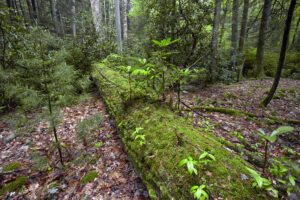by Max Kornetzke, land manager
Growing up, I used to look down at the fractures in the sidewalk as I walked home from school. As I looked down, I projected a map onto the pavement. Each crack was a river, an archipelago, a series of peaceful nation states. As an adult I find myself still staring at the ground, but what catches my eye now are the plants and terrestrial life forms growing around us.
 One of my favorite things to gaze upon are the fallen trees and woody debris that you can find across our preserve and any healthy, mature forest. Each fallen log is a sculpture, a microcosm, a place where death offers more life. Fallen trees and large branches offer a host of lifeforms space to thrive and reproduce. Fungi, lichen, insects, mosses, herbs, shrubs, trees, and many other animals all find these places food and home.
One of my favorite things to gaze upon are the fallen trees and woody debris that you can find across our preserve and any healthy, mature forest. Each fallen log is a sculpture, a microcosm, a place where death offers more life. Fallen trees and large branches offer a host of lifeforms space to thrive and reproduce. Fungi, lichen, insects, mosses, herbs, shrubs, trees, and many other animals all find these places food and home.
Dead fallen trees are an integral component to the life cycle of a healthy forest. As the wood decays from fungal action it becomes a sponge, absorbing and retaining moisture, proffering the next generation of trees a perfect substrate to germinate and grow. On our preserve these dead trees, or nurse logs, are a great place to find young white cedar (Thuja occidentalis), eastern hemlock (Tsuga canadensis) and yellow birch (Betula alleghaniensis).
Fallen trees and woody debris also create habitat by the creation of complex forest topography. When the tree falls over, the root mass is often uplifted, leaving behind a pit and mound structure. Pits often offer the chance for ephemeral ponds to form, creating spawning grounds for various animals. Mounds act similarly to nurse logs, offering places for trees to germinate and critters to live. Areas with many converging fallen branches are also wonderful places for trees to regenerate. They create obstacles that prevent herbivores from over-browsing young seedlings, a problem we often face today with an over-abundant population of white-tailed deer.
As these new trees grow, they intake carbon dioxide through photosynthesis and create sugars that store this carbon within their roots, branches, and woody structures. When they die and fall to the forest floor, this carbon is very slowly released back into both the soil and the atmosphere. This process of trees capturing carbon through photosynthesis and slowly releasing carbon through decomposition is a natural carbon cycle. The dead tree decays slowly, releasing carbon slowly, enriching soil slowly, all while providing new habitat for successive generations to grow, thrive, and repeat the life and death cycle again.
Photo credit: MICHAEL P. GADOMSKI / SCIENCE SOURCE / SCIENCE PHOTO LIBRARY
